Thought there was only one type of filter cartridge out there? Think again. There are now a whole host of filter cartridges available, with different designs and purposes.
In this guide, we’ve shared everything you need to know about the most common water filter cartridge types. By the end, you’ll know which filter cartridges you need to tackle the problem contaminants in your water supply.
Table of Contents
🤔 What Are Filter Cartridges?
It might sound like an obvious question, but just in case you need clarification: a water filter cartridge is a cylindrical canister that contains filter media.
Water filter cartridges are most commonly found in multi-stage under-sink filters and whole house filtration systems. These cartridges sit inside filter housings in a filter system.
The media in a filter cartridge usually has a certain capacity, or lifespan. When the media becomes completely saturated with contaminants, the cartridge needs to be replaced in the filter housing.
Note: We’re purely talking about filter cartridges in this guide, not the other types of filtration media, processes, and technologies. Other websites are making false claims about “UV light filter cartridges” and other cartridges that simply don’t exist. They don’t know their stuff.
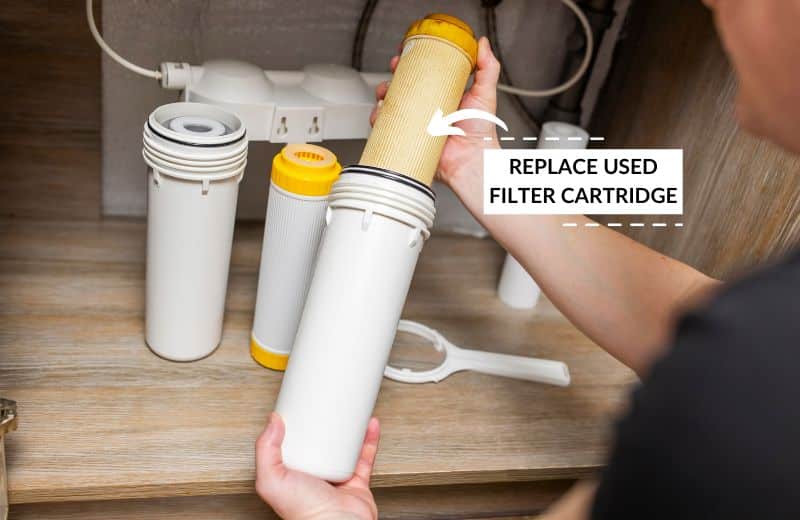
📋 Types of Water Filter Cartridges
Let’s take a look at the most common types of water filters that exist in cartridge form.
Sediment Filter Cartridges
Sediment filters are popular water filter cartridges for whole home installation, or pre-filtration on a point of use system..
A sediment filter traps large, solid particles, like dust, dirt, and rust, in water. This type of filtering cartridge is either installed as a standalone filter or as a pre-filter stage before a whole house water filtration system.
There are two common types of sediment filters:
- Depth filter cartridges (or spun-cartridge filters)
- Surface filter cartridges (or pleated filters)
Depth filters are typically made from melt-blown string, and gradually remove smaller and smaller impurities as water passes through the filter to the core. Surface filters have a large surface area with a pleated paper design and retain particles on the surface of the media. Depth filters are usually more expensive, and last longer, than surface filters.
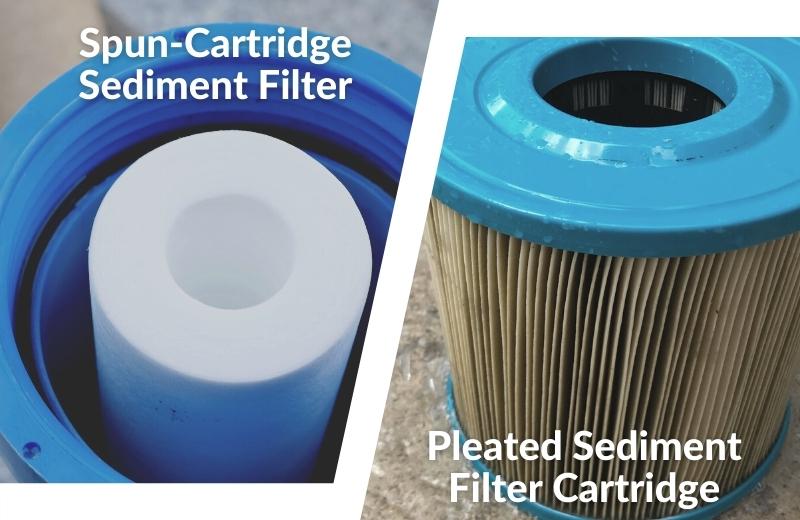
Sediment cartridge filters have a variety of pore sizes to target particles from 0.1 microns to 10 microns or bigger.
Why isn’t a sediment filter typically used as a standalone filter cartridge? Because sediment filter media can only remove particles with relatively high micron ratings. Contaminants with low micron ratings, like chemical contaminants, heavy metals, and microbes, will simply slip through a surface filter or depth filter designed for sediment removal.
Sediment water filters have a lifespan of around 6-9 months depending on the micron size it is filtering.
Related: What micron filter is best for well water?
Ceramic Filters
Ceramic filters have a ceramic surface that consists of tiny pores that filter water to remove sediment, turbidity, and bacteria. Ceramic cartridges are versatile and affordable filter types, and can be installed at your water line or used as portable drinking water treatment devices.
The ceramic cartridge sends water through a network of pores, around half a micron in size, trapping contaminants that are too large to pass through. Gravity-fed, countertop, and under-sink systems all use ceramic filters.
The filtration process mimics the natural purification process on the earth’s surface. Ceramic filters can be used alone or combined with carbon or ion exchange resins to remove a greater range of harmful toxins.
On average, a ceramic filter lasts for about 12 months before water pressure drops and the filter needs to be replaced.
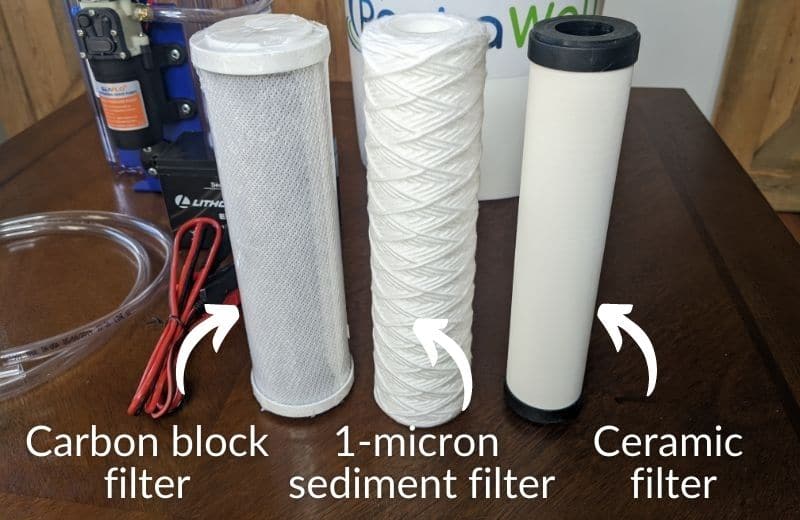
Reverse Osmosis Membranes
Reverse osmosis membranes are included in a reverse osmosis system, usually alongside an activated carbon cartridge, a sediment pre-filter, and a post-filter. Reverse osmosis water filters are most commonly installed as under-sink or countertop drinking water treatment units.
The semi-permeable membrane in this type of cartridge filter tackles particles of all sizes – even those with the lowest nominal micron rating. Not many filters can remove microscopic organisms like viruses and bacteria, but an RO filter can. RO cartridge filters greatly reduce everything from minerals to salts, heavy metals to chemicals, all within a single filter stage.
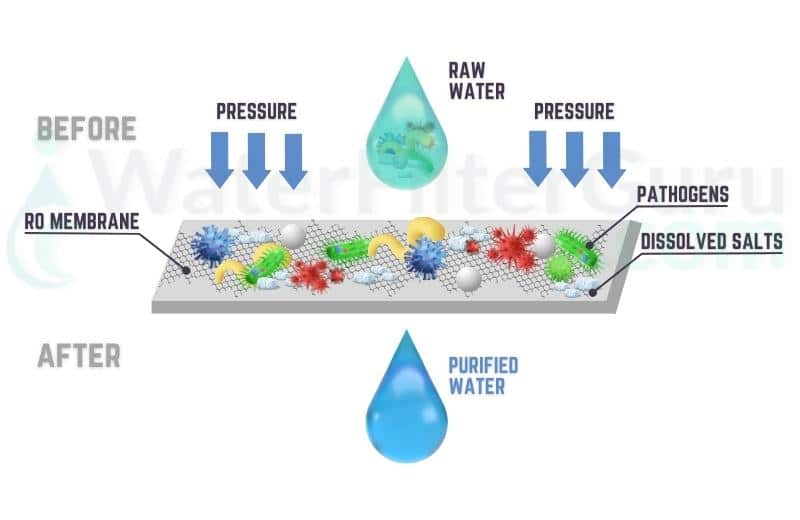
The design of a reverse osmosis membrane is unique from other point of use or whole house filter cartridges. The membrane doesn’t adsorb or grab onto contaminants – instead, it rejects them, acting as a barrier that contaminants rebound off. The contaminants that are unable to pass through the membrane are drained away in a small amount of wastewater.
RO membranes usually last up to 2 years.
Ultrafiltration Cartridges
Ultrafiltration cartridges are similar to RO membranes, but they’re not quite as capable. While RO membranes can remove contaminants as small as 0.0005 microns in size, ultrafiltration targets contaminants with a micron rating of 0.01 or higher.
Ultrafiltration membranes are capable of removing large microorganisms, like bacteria, as well as virtually all suspended solids, including chlorine fluoride, pesticides, herbicides, salt, water hardness, and heavy metals.
An ultrafiltration cartridge can be used alone or alongside another water filter, like a carbon filter, to remove bad tastes and odors as well as suspended solids.
Most ultrafiltration cartridges last for about 1 year.
Granular Activated Carbon Filters
Granular activated carbon, or GAC filters, are porous, highly adsorbent filters that use chemical reactions and adsorption to eliminate bad taste and odor.
GAC is a popular media for whole house water filters, RO systems, and under-sink applications, because of its effectiveness in removing chlorine, pesticides, and disinfection byproducts.
Because of their large surface area, these filters allow for high flow rates, which is why they’re particularly popular in whole house applications.
GAC filters last for about 2-6 months before replacement cartridges are needed.
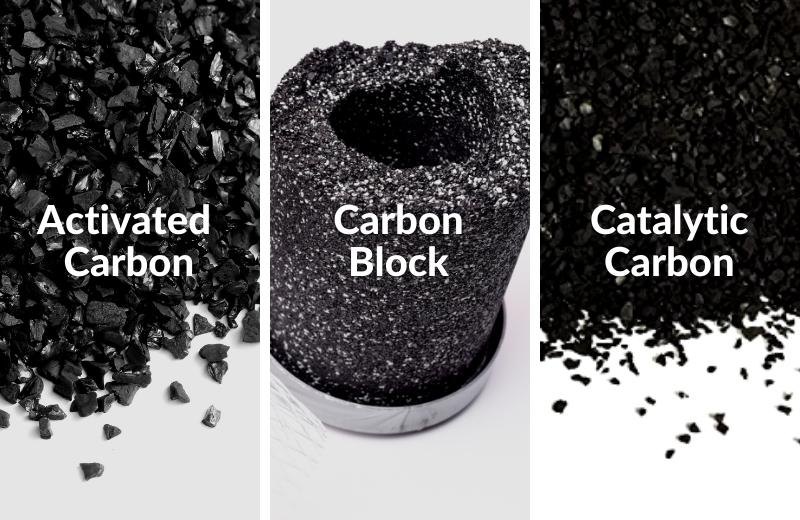
Carbon Block Filters
Carbon block filters provide similar carbon filtration as GAC filters, but they’re bound together in a compressed filter cartridge.
Because of their compact design, carbon block filters are usually installed in under-sink water filter systems, which don’t require a super-high flow rate.
These filters can usually remove impurities with a micron rating of 0.5 to 10 microns, and are ideal for reducing lead, chemicals like chlorine, and sometimes large microscopic organisms.
The lifespan of a carbon block filter is between 3 and 6 months.
Catalytic Carbon Filter Cartridges
Catalytic carbon cartridges are made from activated carbon that has been treated with high-temperature gas processing to change its surface structure.
These cartridge filters remove two contaminants that standard AC filters don’t target: chloramine and hydrogen sulfide.
If your tap water is disinfected with chloramine, not chlorine, look into catalytic carbon filters that target this chemical.
The lifespan of a catalytic carbon filter is about 4-6 months. After this, you’ll notice a water pressure drop, and the cartridge will need to be replaced.
Ion Exchange Cartridge Filters
Ion exchange cartridges remove dissolved and ionized impurities in water. Don’t confuse ion exchange filters with water softeners, which use ion exchange to remove hardness minerals, but are completely different systems that don’t use filter cartridges at all.
Ion exchange whole house water filter cartridges reduce organic substances that other cartridges don’t or can’t remove, like sulfate and arsenic.
While they’re most commonly found in whole house systems, ion exchange cartridges are also installed in point of use applications, like countertop filters and under-sink filters. Ion exchange is usually combined with activated carbon filtration for additional filtration benefits.
The average lifespan of an ion exchange cartridge filter is 3-6 months.
Activated Alumina Cartridges
Activated alumina filters use highly porous, adsorptive treated aluminum ore filter media to reduce up to 90% fluoride. Activated alumina is also used to reduce thallium and uranium.
It’s rare for activated alumina to be used alone. This filter material is commonly used alongside different filter cartridges, including KDF or carbon filters, to remove a large selection of contaminants.
These filters are most commonly used in whole house filtration systems, but they’re sometimes found in under-sink systems, too.
Activated alumina cartridges last for up to 12 months before replacement cartridges are needed.
Related: Looking for a water filter to remove fluoride? Read our reviews here!
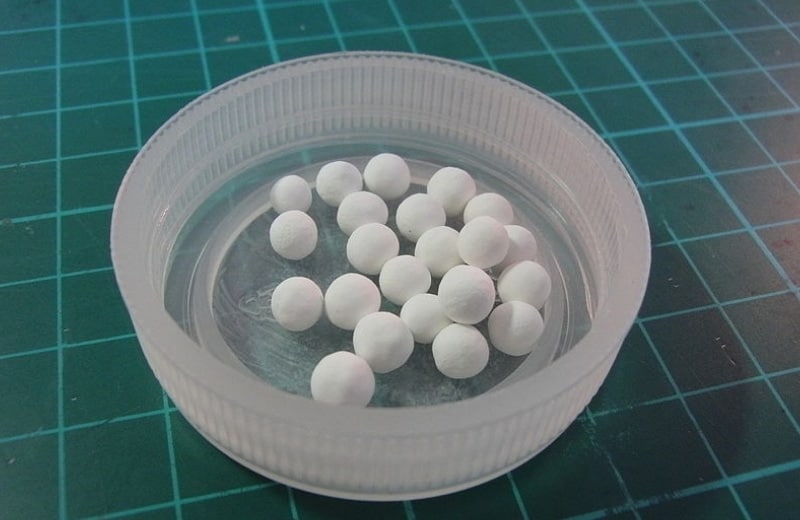
KDF Filter Cartridges
KDF cartridges use a process known as redox to remove chlorine, hydrogen sulfide gas, mercury, lead, chromium, and more. KDF stands for Kinetic Degradation Fluxion, and this filter type uses a copper-zinc media in a single cartridge, or combines this media with other media, like activated carbon.
The design of KDF cartridges also prevents the growth of microbiological contaminants, like algae and bacteria, so you can safely use the filter throughout its advised lifespan.
There are several different types of KDF filters, but the most common types are KDF-55, which removes chlorine and water-soluble heavy metals, and KDF-85, which targets iron and hydrogen sulfide.
📏 Water Filter Cartridge Sizes
Different applications have different-sized filtering cartridges. The bigger the system, and the more space it takes up, the bigger the cartridges can be.
You can find filters in four common sizes:
- 2.5 x 10 inches
- 2.5 x 20 inches
- 4.5 x 10 inches
- 4.5 x 20 inches
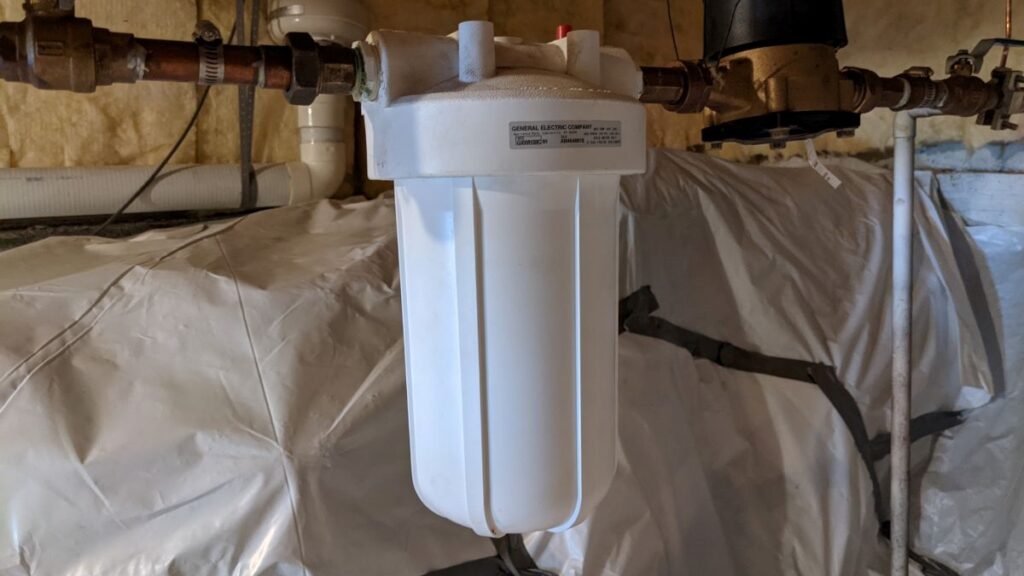
Size affects flow rate, so while the 2.5 x 10 and 2.5 x 20-inch cartridges are fine for point of use applications, they shouldn’t be used in a whole home multi-stage system.
The bigger the cartridge, the more media it contains. This usually (although not always) means that the media lasts longer, and the price point is always higher.

Hi, I have something of a follow up question to the above. My house had an RO system when I moved in, but I’m not a fan of RO. The unit has failed, the parts are proprietary, and the manufacturer is defunct, so it’s time for something new.
I want something that is universal rather than proprietary. This is for drinking water only, not whole house. I am on city water (California), so it’s pretty decent water, but full of bad tastes from flowing hundreds of miles in concrete canals, followed by typical city treatment. I am thinking of 3 or 4 stage filtering, using standard 2.5 x 10″ cartridge filtering. (I need to keep it under-sink where the RO unit currently lives, so no 20″ housings for me!) If possible, I’d like to make use of the current cold water supply (1/2″) and the air-gap faucet (1/4″ line).
I’d like to remove chlorines and fluorides, and make it taste decent. What would you recommend for filter cartridges? I was thinking in the direction of a fairly coarse sediment filter, then a finer sediment filter, then…. what’s next?
Hi Mark, great question! The appropriate filter cartridges to use depend on the contaminants present in the water that need to be treated. I’d highly recommend starting with a certified lab test, then using the data to guide your purchase decision.
Does a universal glossary exist for intrepreting the 3-letter codes for water filter types?
In what order should a three-cartridge 4.5 x 20 system be loaded, i.e. input (first), middle (second), to output (last)?
Not that I know of. The order of cartridges depends on the water issues being treated and treatment technology being used. For example, if you have a sediment filter, carbon filter and ion exchange filter, you would want to install them in that order because each preceding stage works to protect the subsequent stage.
Thank you. The information you provided is very helpful. My problem is that I am in the Philippines and I am having a hard time discovering the water quality and what I need to filter. I am using a standard point of use dual cartridge filter with carbon granule filtration process on both cartridges. It seems to work but I want to more thoroughly change the process because the taste is not the best. I am sure there’s some kind of water authority somewhere on the island of negros where I am. Finding it is a different story. I can buy the cartridges in the local hardware store but there are no experts to tell me what is the best cartridges to use to use in my filter system.
Hey Thomas, thanks for your comment! As a first step, I would recommend reaching out to local laboratories to see if they offer any sort of water analysis. If they do, ask what analytes it tests for. Then you can use the testing data to determine what (if any) additional treatment you need.
For a bit of reference, I was recently in Guatemala and needed to find a lab that could provide a water analysis. I found two local health clinics that had access to laboratories that provided the service I needed.